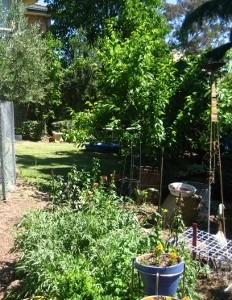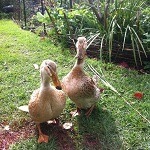Leanne’s garden, based on permaculture principles, was one of those opened recently in our Open Gardens and Tours program. She describes it as being a kind of album of the different garden crazes she has lived through. It has elements of formal and cottage ornamental planting, all white garden, scented garden, something in flower every month garden, native plant garden, sustainable veggie gardening and, of course, permaculture. Because the house was rebuilt about 15 years ago most of the garden, except for some trees, was demolished in the process. She says that she didn’t plan – just started digging and that things just worked out.
Front Garden
Leanne says she wanted something easily maintained so that it wouldn’t annoy her when her when she walked past all the weeds – something soothing and restful, to unwind going through the garden to the door. So it was ‘designed’ with the following factors in mind:
* It was not used for recreation, was south facing, so not the best for veggies.
* It couldn’t be watered easily from the tanks which at the back of the house, so the plants needed to be hardy.
* It was open to passers-by and slopes down to the front door.
It ended up predominantly native, heavily mulched with wood chips, planted with trees, strappy grasses and a few shrubs, a gravel path to the front door. After a while she found it a little bit boring, so added whimsical items and decorates for events such as Halloween, Christmas and Easter.
Several episodes of heavy rain yielded a pool at the front door, as water ran straight down the path. So a swale was constructed – a type of open channel running horizontally across the block allowing water to soak slowly into the ground It is filled with gumnuts, rather than pebbles to mimic a dry creek bed.
The nature strip is planted with a mixture of Australian native plants and other hardy species.
Back Garden
 The back garden is divided into zones according to permaculture principles based on the amount and frequency of input. Vegetables are in Zone 1 with paths of wood chips or sawdust, which can be shovelled onto the beds as they break down. The poultry are in Zone 2 and the “Food Forest” of productive trees is Zone 3. The wild area at the back of this larger than average suburban block is Zone 4 because of lack of time to do much else with it. Zone 4 also has a bee hive, hosted on behalf of a permaculture bee keeping society.
The back garden is divided into zones according to permaculture principles based on the amount and frequency of input. Vegetables are in Zone 1 with paths of wood chips or sawdust, which can be shovelled onto the beds as they break down. The poultry are in Zone 2 and the “Food Forest” of productive trees is Zone 3. The wild area at the back of this larger than average suburban block is Zone 4 because of lack of time to do much else with it. Zone 4 also has a bee hive, hosted on behalf of a permaculture bee keeping society.
Three worm farms are set up under fruit trees so that the juices run straight out onto the trees. The compost bin is placed wherever compost is needed. The bin, when full, is moved elsewhere and the compost pile dug over occasionally until it can be planted up.
Permaculture concepts
Integrated pest management using beneficial insects to control the harmful ones. So there many plants with flowers that attract them – such as daisies and members of the carrot family: parsley, coriander and other umbelliferous varieties. Getting this to work requires resistance to pulling out seeding plants or weeds. It also requires resisting the urge to kill insects which may be providing food for the beneficial predators. And exception to this is in regard to snails. Although her ducks eat most of them, when seedlings are very young she uses Multiguard pellets inside exclusion cages (old bird cages) until plants are large enough to fend for themselves. She uses the capacity of a broad range of plantings which attract a variety of insects, animals and birds as an excuse for buying plants which she likes, but which have no obvious use. The biggest pests are possums and citrus gall wasp.
Chop and Drop – leaving tree prunings in piles so that they provide mulch for the trees and nutrients for the soil as they break down. Lawn clippings can be tossed over them as well and will not form big water resistant clumps because the twigs keep them a bit broken up.
 Using poultry as part of the permaculture system – chooks and ducks are able to free range under the trees when someone is around to supervise their safety. They clear up pests, such as codling moth, from under the apples, scratch around and reduce weeds while fertilising the ground. They also turn mulch into compost. They can be used in the veggie garden with similar results, but I find them a bit too enthusiastic with the weeding.
Using poultry as part of the permaculture system – chooks and ducks are able to free range under the trees when someone is around to supervise their safety. They clear up pests, such as codling moth, from under the apples, scratch around and reduce weeds while fertilising the ground. They also turn mulch into compost. They can be used in the veggie garden with similar results, but I find them a bit too enthusiastic with the weeding.
Edible plants
| Jerusalem Artichokes Lemon Cumquat Apple: Pinkabelle Sugarcane Almond Plum Pepper Bush Boysenberries White Sapote |
Asparagus Lime Mandarin x Crabapples Golden Hornet Persimmon Peach Pluots Lemon Myrtle Olives |
Rhubarb Makrut Apple: Granny Smith Banana Pomegranate Apricot Feijoas Strawberry Elderberry |
Globe Artichokes Lime Orange Apple: Red Delicious Avocado Cherry Medlar Quinces Grape Dragon Fruit |
Related Articles:
Garden Journaling – Slow down to tune in.
As we move through the year and our gardens evolve, there's something magical about documenting the journey. Garden journaling is an art that enables…
The Importance of building soil health for a biodeverse, productive garden
Creating a thriving garden that not only sustains itself but also contributes to the broader ecosystem requires more than just sunlight and water.…



